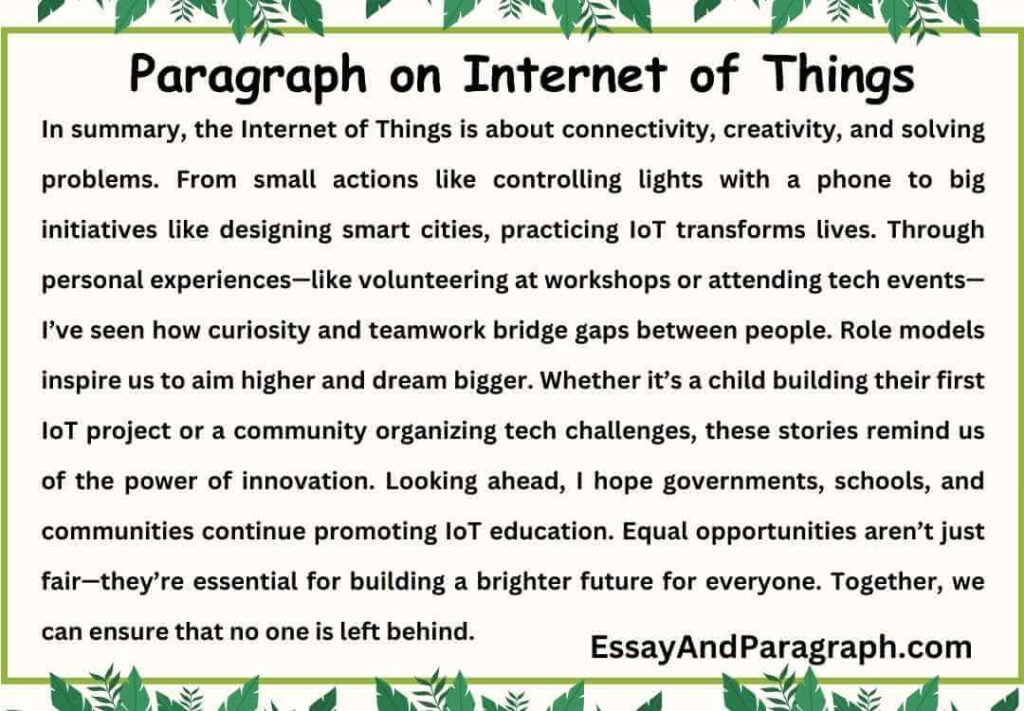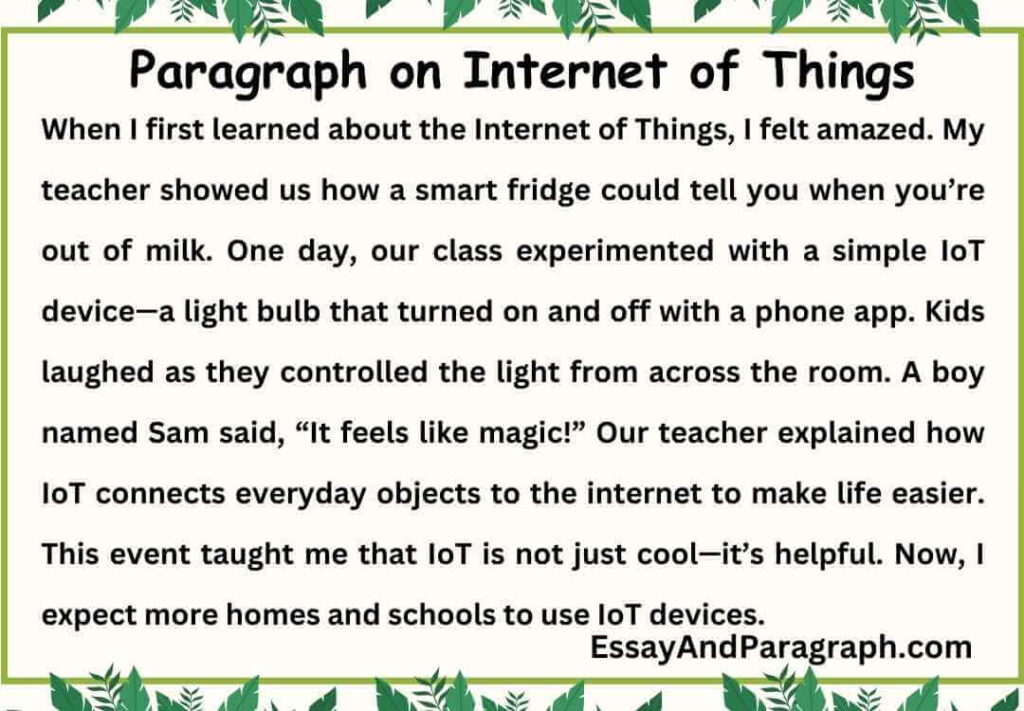Have you ever wondered how your smartwatch talks to your phone or how your home lights turn on with just a voice command? The Internet of Things (IoT) makes all this possible! As someone who has studied and written about technology for years, I’m excited to share simple yet fascinating ideas with you. In this article, we will learn how to write paragraphs on the Internet of Things in different lengths (100, 150, 200, 250, and 300 words). By the end, you’ll understand why IoT matters and how it’s shaping our lives. Let’s dive into this exciting topic together!
Paragraph on Internet of Things [100 words]
When I first learned about the Internet of Things, I felt amazed. My teacher showed us how a smart fridge could tell you when you’re out of milk. One day, our class experimented with a simple IoT device—a light bulb that turned on and off with a phone app. Kids laughed as they controlled the light from across the room. A boy named Sam said, “It feels like magic!” Our teacher explained how IoT connects everyday objects to the internet to make life easier. This event taught me that IoT is not just cool—it’s helpful. Now, I expect more homes and schools to use IoT devices.

Paragraph on Internet of Things [150 words]
The idea of the Internet of Things made me curious and excited. Last summer, my school held an IoT workshop where students learned how devices talk to each other. At first, some kids were confused because they didn’t know how IoT worked. But soon, everyone was laughing as they connected sensors to track temperature and humidity. Volunteers like my friend Mia helped explain how IoT helps farmers monitor crops or doctors check patients remotely. These interactions showed me how useful IoT can be. After the workshop, many students felt inspired to learn more about technology. Some even started dreaming of becoming IoT engineers. The outcome was inspiring—people realized they could create amazing things. Looking ahead, I hope more communities offer programs like this. IoT isn’t just about gadgets; it’s about solving real-world problems.
Paragraph on Internet of Things [200 words]
Learning about the Internet of Things filled me with determination. Recently, my class visited a tech museum where kids from different schools gathered to explore IoT. We saw a smart garden where plants watered themselves using sensors. One girl, Lily, said, “I want to build something like this someday!” Our teacher explained how IoT connects devices to make life smarter and more efficient. Back at school, we organized an “IoT challenge” where students created simple projects, like a doorbell that sends alerts to phones. Seeing classmates cheer after completing their projects reminded me that teamwork brings success. Moving forward, I believe more schools will teach kids about IoT. The Internet of Things ensures that no one feels left out. Every small step toward learning technology makes the world a better place.
Paragraph on Internet of Things [250 words]
Thinking about the Internet of Things always makes me optimistic. Imagine a world where IoT helps farmers, doctors, and teachers every day. Last year, I attended a workshop where students practiced creating IoT solutions to solve real-world problems. Groups were given tasks, like designing a system to monitor air quality or track lost pets. At first, disagreements arose, but mentors encouraged us to listen and work as a team. One group decided to build a smart trash bin that alerts cleaners when it’s full. These activities proved that creativity builds stronger solutions. After the workshop, our school started holding regular IoT days where students could experiment. Teachers noticed fewer conflicts and more cooperation. Parents praised the initiative, saying their children seemed more confident. Looking ahead, I expect more schools to adopt programs like this. The Internet of Things ensures that no one feels ignored. When we stand together, amazing things happen. Every small step toward innovation makes the world a better place.
Paragraph on Internet of Things [300 words]
The Internet of Things fills me with hope because it promises fairness and happiness for all. A few months ago, I volunteered at a center that taught kids how to design and use IoT devices. Many families struggled to afford expensive tools, so volunteers provided free kits and guidance. To assist them, tech experts held sessions explaining how IoT works and why it matters. I met Fatima, a girl who dreamed of becoming an engineer but lacked confidence. With encouragement from mentors, she built her first IoT project—a smart watering system for plants. Her progress inspired others around her. During gatherings, kids shared their creations, laughed, and learned from each other. These interactions broke down walls and built trust. Over time, Fatima won a local IoT competition. Watching her transformation moved me deeply. It reminded me that opportunity changes lives. After volunteering, I realized how much communities gain when they embrace IoT. Looking to the future, I imagine a world where everyone participates in learning technology. Governments, organizations, and individuals must work together to remove barriers. The Internet of Things ensures that talent and hard work are rewarded, no matter who you are. Together, we can build a brighter tomorrow for all.
FAQs on Internet of Things
What is the Internet of Things?
The Internet of Things (IoT) refers to devices connected to the internet that can communicate with each other. Examples include smartwatches, thermostats, and security cameras. IoT makes life easier by automating tasks and providing real-time data.
Why is IoT important?
IoT is vital because it improves efficiency and solves problems. For instance, IoT helps farmers monitor crops, doctors track patients’ health, and cities reduce traffic. Investing in IoT benefits everyone by advancing industries and improving daily life.
How can students learn about IoT?
Students can join IoT workshops, attend tech events, or use online tools to create simple IoT projects. Schools often provide kits and apps for hands-on learning. Organizing competitions or challenges also encourages creativity. Every effort counts toward mastering technology.
What challenges hinder IoT?
Challenges include high costs, lack of awareness, and security concerns. For example, not all schools have IoT programs. Overcoming these requires funding, education, and collaboration. Progress takes time, but every step matters.
Can IoT improve societies?
Absolutely! IoT improves societies by making systems smarter and more efficient. For example, smart grids reduce energy waste, and wearable devices help people stay healthy. Investing in IoT creates lasting benefits for everyone.
Quotes Related to Internet of Things
- “The Internet of Things is transforming the everyday physical objects that surround us into an ecosystem of information.” – Unknown
- “With great power comes great responsibility.” – Spider-Man (relevant to IoT’s impact)
- “Technology is nothing. What’s important is that you have faith in people.” – Steve Jobs
- “The best way to predict the future is to invent it.” – Alan Kay
- “IoT is not just about connecting devices; it’s about connecting lives.” – Unknown
- “Innovation distinguishes between a leader and a follower.” – Steve Jobs
- “We are stuck with technology when what we really want is just stuff that works.” – Douglas Adams
Summary on Internet of Things
In summary, the Internet of Things is about connectivity, creativity, and solving problems. From small actions like controlling lights with a phone to big initiatives like designing smart cities, practicing IoT transforms lives. Through personal experiences—like volunteering at workshops or attending tech events—I’ve seen how curiosity and teamwork bridge gaps between people. Role models inspire us to aim higher and dream bigger. Whether it’s a child building their first IoT project or a community organizing tech challenges, these stories remind us of the power of innovation. Looking ahead, I hope governments, schools, and communities continue promoting IoT education. Equal opportunities aren’t just fair—they’re essential for building a brighter future for everyone. Together, we can ensure that no one is left behind.




